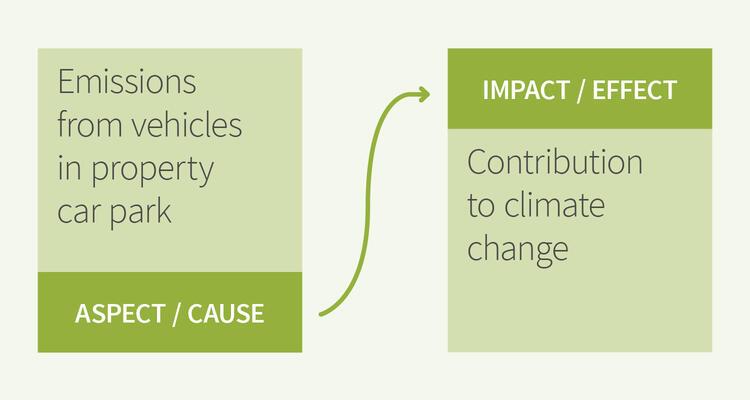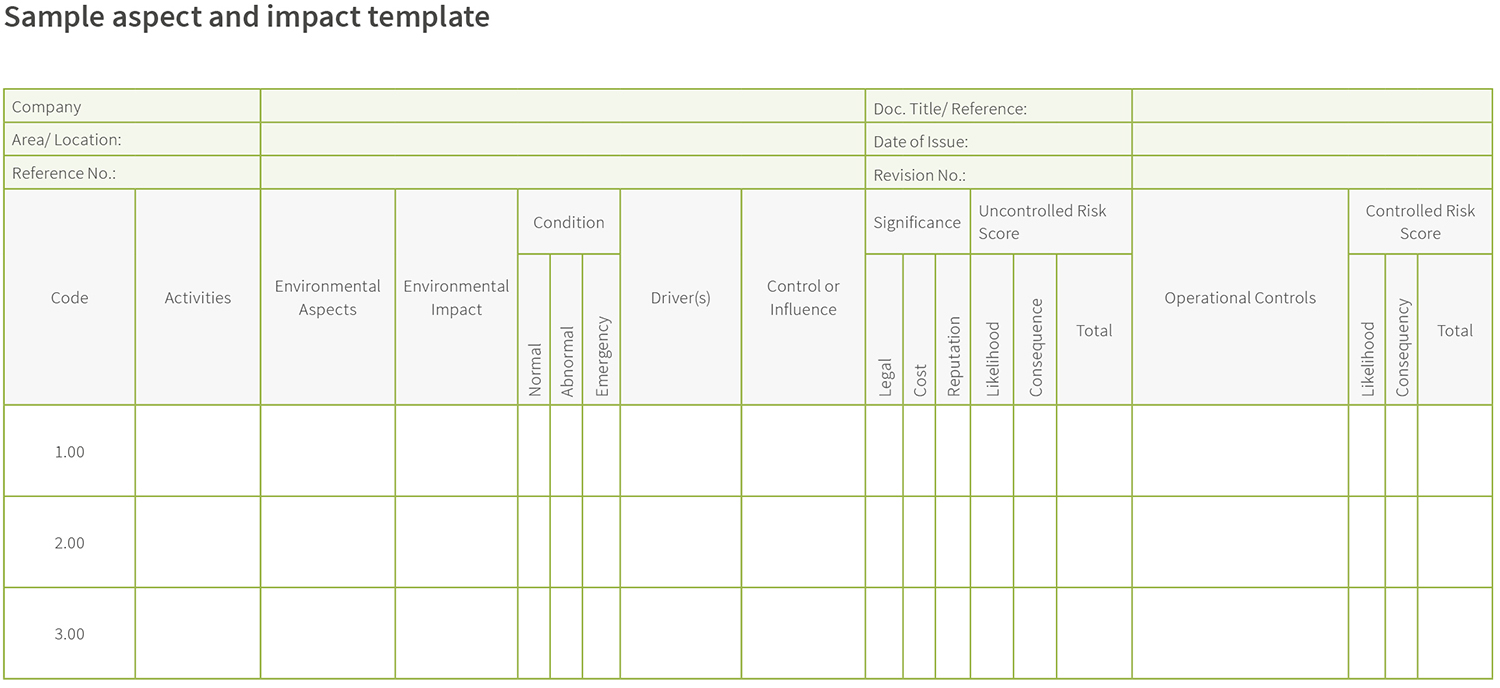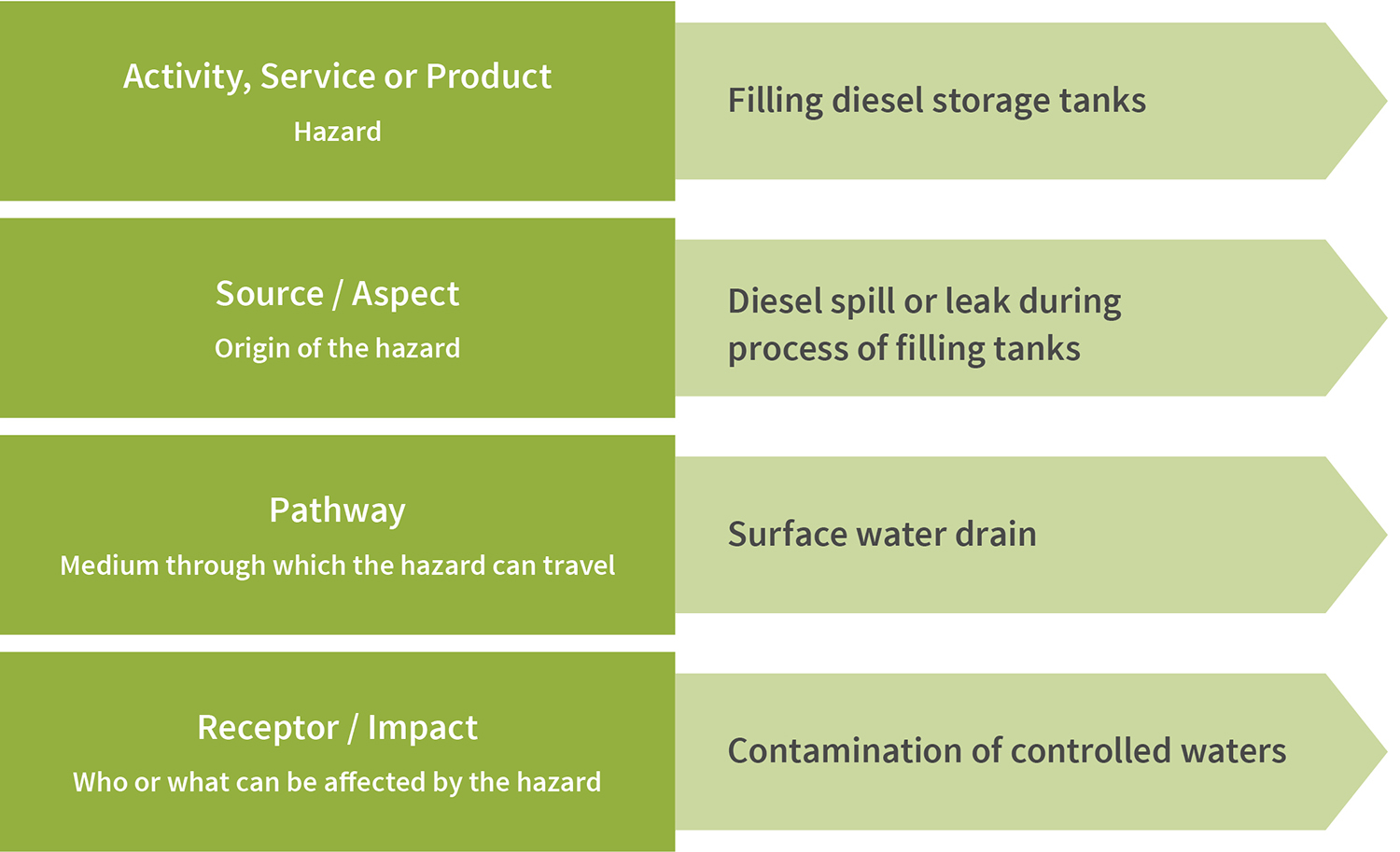GN 1.3: Environmental aspects and impacts
Guidance Note purpose
The purpose of this Guidance Note is to guide asset managers, property managers and facilities managers in undertaking an environmental aspect and impact assessment in relation to real estate.
Context
An environmental aspect and impact assessment is a central component of the process of managing environmental risk. When applied to real estate, the assessment involves evaluating the way in which the activities associated with a property interact with, and impact on, the environment.
BS EN ISO 14001:20151, which provides a leading certification standard for Environmental Management Systems, provides the following definitions:
- Environmental aspect: An element of an organisation’s activities, products or services that interacts, or can interact, with the environment.
- Environmental impact: A change to the environment, either adverse or beneficial, wholly or partly resulting from an organisation’s aspects.
In simple terms, an environmental aspect and impact assessment relates to the cause (aspect) of a change and the effect (impact) of a change to the environment.
Example of environmental aspect and impact

Importance
The process of undertaking an environmental aspect and impact assessment enables the identification and prioritisation of environmental risks and supports understanding about the extent to which these risks are effectively managed.
Developing and implementing an environmental aspect and impact helps to ensure that environmental risks are considered consistently across all activities associated with a property and, where relevant, throughout a portfolio.
The assessment process brings key property stakeholders together to determine the cause and effects associated with environmental risks. This helps to identify the appropriate risk owners, who should be responsible for developing risk control measures.
An aspect and impact assessment provide an important step in connecting the various component parts of environmental risk management. It provides a structured, end-to-end method to populating an environmental risk register, along with an evidence-based approach to explaining how and why the selected risks have been chosen.
Demonstrating the effective implementation of an aspect and impact assessment is a requirement for certification to Environmental Management System Standard ISO 14001.
Responsibilities & Interests
The table below summarises the key activities associated with collating and evaluating environmental risks, and highlights where asset managers, property managers and facilities managers are likely to have a responsibility or specific interest.
- AM - Asset Manager
- PM - Property Manager
- FM - Facilities Manager
Step 1: Design an aspect and impact template
Stakeholder:
Step 2: Scope activities and review aspects and impacts
Stakeholder:
Step 3: Understand the context of each aspect and impact
Stakeholder:
Step 4: Evaluate the risk
Stakeholder:
Step 5: Consider risk controls and their effect on significance
Stakeholder:
Step 6: Submit significant risks to a risk register
Stakeholder:
How to
Intro
Usually, the responsibility for undertaking an aspect and impact assessment will be by an asset manager, in alignment to a wider corporate risk framework. The process of undertaking the assessment is often coordinated by a property manager, with input from a facilities manager where required.
Undertaking an environmental aspect and impact assessment generally considers the following steps:
Step 1: Design an environmental aspect and impact template
It is important that a set template is used to capture the output from an aspect and impact assessment. The template is also helpful in facilitating discussion as the process moves through its various stages.
While templates vary, it is important that the following information in included in the template:
- Activity.
- Aspect.
- Impact.
- Condition.
- Drivers.
- Level of control.
- Significance (Uncontrolled).
- Risk control.
- Significance (Controlled).
There are a wider range of environmental aspect and impact assessment templates available on-line. An example is provided below:

Step 2: Scope activities and review aspects and impacts
Embarking on an environmental aspect and impact assessment involves determining the organisation scope of the assessment. For real estate, for example, this may be determined as:
- Including the activities that take place within the site boundary.
- Selecting a wider boundary, including transport to and from the building.
A useful step in initiating the aspect and impact process is to convene a working group of individuals who can represent the different departments responsible for managing the property. This may include, for example, facilities, human resources, procurement, security and cleaning.
Through facilitated discussion, the working group should review the range of activities undertaken at the property and consider the way in which these activities interact with the environment, and what the resulting environmental impact is likely to be.
It is unlikely that a definitive list of activities, aspects and impacts will be established through a single discussion. This list will evolve over time as working group participants consider the process, and the characteristics and nature of the activities they are responsible. This information can be captured in ‘Activities’ Environmental Aspects’ and ‘Environmental Impacts’ columns of the sample aspect and impact template.
There are various methods that can be adopted to support the facilitated discussion. One of these methods is the source-pathway-receptor model. This approach assists an organisation in determining hazards relevant to its activities, services and products and how these hazards can interact with and impact on the environment.

Step 3: Understand the context of each aspect and impact
To support the delivery of useful information, some further information about each aspect and impact is necessary. This information falls into the following sections
- Condition: Relating to whether the activity takes place in normal, abnormal or emergency situations.
- Normal: For example, during normal operations of the property.
- Abnormal: For example, during a planned refit.
- Emergency: For example, in the event of a spillage.
- Driver: The reason why the environmental impact is important.
- Legal: Noting the legal or regulatory requirement associated with the aspect and impact
- Cost: Noting the scale of financial consequence associated with the aspect and impact
- Reputation: Noting the stakeholder interest associated with the aspect and impact
- Control: The level of control the property manager has over the aspect and impact
- Control: The property manager has direct control
- Influence: The activity is implemented or contracted out to a third party
Step 4: Evaluate the risk
The significance risk associated with each aspect and impact should be evaluated by the individuals in the working group. At this stage, the evaluation focuses on ‘uncontrolled risk’, i.e. the risk associated without any mitigation in place.
The evaluation of risk should consider:
- Severity of the impact
- Likelihood of the impact occurring
There are various methods available to rate significance. It is useful if the method selected for the aspect and impact assessment aligns with the risk evaluation method adopted by the asset manager of the property for other areas of risk management.
Step 5: Consider risk controls and their effect on significance
Following the evaluation of uncontrolled risk, individuals in the working group should consider the mitigation that is in place for each aspect and impact.
Risk controls can be wide ranging, for example:
- Operational controls and procedures for undertaking specific tasks, for example segregating hazardous materials from general waste for disposal.
- Management controls, for example, the provision of training to procurement colleagues staff relating to the selection of low-environmental impact materials.
- Physical controls for example a bunding around an oil tank.
Following the identification of the controls accompanying each aspect and impact, the associated risk should be re-evaluated to consider the effectiveness of the mitigation.
The outcome of the re-evaluation is to ascertain whether the control method has reduced the risk to an acceptable level, i.e. a level that is no longer significant. Where the level of controlled risk remains significant, or where no control exists, the aspect and impact should be raised for attention of the property manager for action.
Step 6: Submit significant risks to a risk register
On completion of the assessment, aspects and impacts with an uncontrolled risk rating of ‘significant’; should be added to a property or portfolio risk register. This should include information about the associated controls and the roles responsible for maintaining these.
The aspect and impact assessment should be reviewed on a regular basis, for example one to two years, and also where there is a significant change to the organisation or operation.
Related Guidance Notes
The following Guidance Notes contain related information:
- GN1.1: Collating and evaluating environmental risks
- GN1.2: An environmental compliance register
- GN1.4: The wider risk context
- GN1.5: Environmental risk control and assurance
- GN2.1: An asset register
- GN4.3: Air conditioning inspections
- GN4.8: Template action plan
- GN4.9: Energy efficiency opportunities
- GN5.1: Leak inspections
- GN5.4: Water efficiency opportunities
- GN 6.4: Waste management opportunities
- GN7.1: Sustainable transport opportunities
- GN 8.2: Social value opportunities
- GN 8.3: Incorporating social value within the supply chain
- GN11.2: Engaging occupiers
- GN12.1: Biodiversity baseline
- GN13.2: Health and wellbeing opportunities